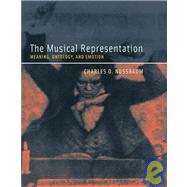
| Preface: Unwrapping the Riddle | p. xi |
| General Introduction: What Is a Naturalistic Philosophical Theory of Musical Representation? | p. 1 |
| The Musical Affordance | p. 23 |
| Three Varieties of Musical Representation | |
| The Musical Utterance | p. 87 |
| How Music Means | |
| The Musical Work | p. 143 |
| From Musical Representation to Musical Emotion | p. 189 |
| Nausea and Contingency | p. 259 |
| Musical Emotion and Religious Emotion | |
| General Summary and Conclusion | p. 301 |
| Solving the Riddle | |
| Notes | p. 303 |
| References | p. 355 |
| Index | p. 375 |
| Table of Contents provided by Publisher. All Rights Reserved. |
The New copy of this book will include any supplemental materials advertised. Please check the title of the book to determine if it should include any access cards, study guides, lab manuals, CDs, etc.
The Used, Rental and eBook copies of this book are not guaranteed to include any supplemental materials. Typically, only the book itself is included. This is true even if the title states it includes any access cards, study guides, lab manuals, CDs, etc.